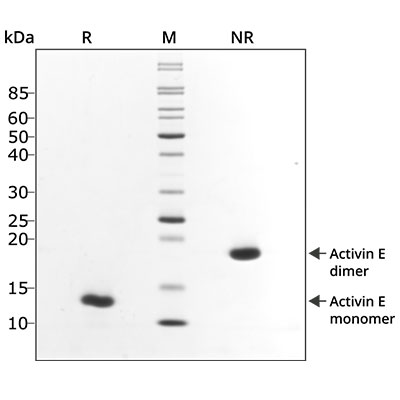 Recombinant human activin E PLUS™ protein (Qk067)
Recombinant human activin E PLUS™ protein (Qk067)Recombinant human activin E PLUS™ protein (Qk067)
Price range: £290.00 through £3,600.00
Human recombinant activin E PLUS™ protein is an optimized biologically active truncation of the mature domain of human activin E protein. Activin E is a member of the transforming growth factor-beta (TGF-ß) superfamily, a group of proteins that play key roles in regulating cell growth, differentiation, and inflammation. The tag-free form of activin E PLUS™ is of significant interest for drug discovery across various field. Recombinant human (Qk082) and mouse (Qk008) Avi-tag activin E PLUS™ are also available on request.
High purity 23.2 kDa dimer comprising truncated mature domain, animal origin-free (AOF) and carrier-protein free (CF).
In stock
Orders are typically shipped same or next day (except Friday).
Easy world-wide ordering, direct or through our distributors.
Price range: £290.00 through £3,600.00
Buy online with secure credit card or purchase order. For any questions, please email orders@qkine.com
Summary:
- Highly pure optimized form of the mature domain of activin E (UniProt: P58166)
- 23.2 kDa (dimer)
>98%, by SDS-PAGE quantitative densitometry
Expressed in E. coli
Animal origin-free (AOF) and carrier protein-free
Manufactured in our Cambridge, UK laboratories
Lyophilized from acetonitrile, TFA
- Resuspend in 10 mM HCl (Reconstitution solution A) at >50 µg/ml, add carrier protein if desired, prepare single-use aliquots and store frozen at -20 °C (short-term) or -80 °C (long-term)
Featured applications:
Drug discovery in endocrinology
Drug discovery in inflammation
Drug discovery in metabolism

Recombinant activin E PLUS™ activity was determined using a Smad reporter assay in HEK293 cells co-transfected with the activin E co-receptor ALK7. Cells were treated in triplicate with a serial dilution of activin E PLUS™ for 6 hours. Firefly activity was measured and normalised to the control Renilla luciferase activity. Data from Qk067 lot 204646. EC50 = 0.16 ng/ml (6.8 pM).
Recombinant activin E PLUS™ migrates as a major band at approximately 23 kDa (dimer) in non-reducing (NR) conditions. Upon reduction (R), only the monomer band at approximately 12 kDa is visible. No contaminating protein bands are present. The purified recombinant protein (3 µg) was resolved using 15% w/v SDS-PAGE in reduced (+β-mercaptoethanol, R) and non-reduced (NR) conditions and stained with Coomassie Brilliant Blue R250. Data from Qk067 lot #204646.

Further quality assays
Mass spectrometry: single species with expected mass
Recovery from stock vial: >95%
Endotoxin: <0.005 EU/μg protein (below level of detection)
We are a company founded and run by scientists to provide a service and support innovation in stem cell biology and regenerative medicine. All our products are exceptionally high purity, with complete characterisation and bioactivity analysis on every lot.
Protein background
Activin E is a member of the TGF-beta superfamily, a group of proteins that play a key role in regulating cell growth, differentiation, and inflammation. Like other activins, activin E is a dimeric protein, consisting of two subunits connected by a disulfide bond. These subunits are produced from precursor molecules that undergo cleavage to form the active protein. Activin E has a characteristic cystine knot motif, common in the TGF-beta family and crucial for its function [1].
Activin E was initially identified for its role in reproductive biology but has since been implicated in broader biological processes, including metabolic regulation. It is primarily expressed in the liver and has been implicated in the regulation of glucose and lipid metabolism [2,3]. It has been detected in adipose tissue and the gastrointestinal tract.
Activin E signals through the ALK7 receptor in liver and adipose tissues, specifically using the ActRIIA and ActRIIB receptors, while resisting antagonists like follistatin [1]. Receptor binding activates the SMAD2/3 pathway in adipocytes, linking it to adipose tissue regulation and positioning it as a potential target for treating obesity and metabolic disorders by enhancing insulin sensitivity and thermogenesis. Blocking activin E may also serve as an anti-diabetic strategy by improving adipose energy metabolism [1].
Activin E shares functions with other activins, such as enhancing follicle-stimulating hormone (FSH) binding in the ovarian follicle, promoting spermatogenesis, and participating in androgen synthesis. These varied roles make it a protein of interest for drug discovery across multiple fields, including endocrinology, metabolism, and inflammation. Understanding the activin E signaling pathways and biological effects could open new avenues for therapeutic interventions in obesity, diabetes, and other metabolic diseases [2].
Additional resources
Our products are for research use only and not for diagnostic or therapeutic use. Products are not for resale.
For use in manufacturing of cellular or gene therapy products. Not intended for in vivo applications.

Receive an Amazon gift voucher when you leave us a review.
£25, $30 or €30 for reviews with an image and £10, $15 or €15 for reviews without an image

